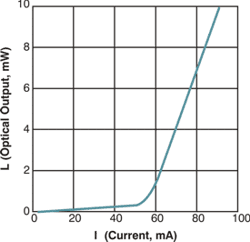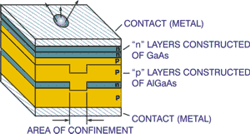Lambertian Emitter: An emitter that radiates according to Lambert’s cosine law, which states that the radiance of certain idealized surfaces depends on the viewing angle of the surface. The radiant intensity of such a surface is maximum normal to the surface and decreases in proportion to the cosine of the angle from the normal. Given by: |
N = N0cosA
Where:
N = radiant intensity
N0 = radiance normal to an emitting surface.
A = angle between the viewing direction and the normal to the surface. |
| LAN (Local Area Network): A communication link between two or more points within a small geographic area, such as between buildings. Smaller than a metropolitan area network (MAN) or a wide area network(WAN). |

|
| Large Core Fiber: Usually, a fiber with a core of 200 µm or more. |
|
| Large Effective Area Fiber (LEAF): An optical fiber, developed by Corning, designed to have a large area in the core, which carries the light. |
| Laser: Acronym for light amplification by stimulated emission of radiation. A light source that produces, through stimulated emission, coherent, near monochromatic light. |
| Laser Diode (LD): A semiconductor that emits coherent light when forward biased. |
|
| Lateral Displacement Loss: The loss of power that results from lateral displacement of optimum alignment between two fibers or between a fiber and an active device. |
|
| Launch Fiber: An optical fiber used to couple and condition light from an optical source into an optical fiber. Often the launch fiber is used to create an equilibrium mode distribution in multimode fiber. Also called launching fiber. |
| L-Band: The wavelength range between 1570 nm and 1610 nm used in some CWDM and DWDM applications. |
| LD: See laser diode. |
| LEAF: See large effective area fiber. |
| Least Significant Bit: In a binary code, the bit or bit position assigned to the smallest quantity or increment that can be represented by the code. |
| LED: See light-emitting diode. |
| LEC (Local Exchange Carrier): A local telephone company, i.e., a communications common carrier that provides ordinary local voice-grade telecommunications service under regulation within a specified service area. |
| LEX: Abbreviation for local exchange. Synonym for central office. |
| LH: Abbreviation for long-haul. A classification of video performance under RS-250C. Lower performance than medium-haul or short-haul. |
| L-I Curve: The plot of optical output (L) as a function of current (I) which characterizes an electrical-to-optical converter. A typical L-I curve is shown at right. |
|
| Light: In a strict sense, the region of the electromagnetic spectrum that can be perceived by human vision, designated the visible spectrum, and nominally covering the wavelength range of 0.4 µm to 0.7 µm. In the laser and optical communication fields, custom and practice have extended usage of the term to include the much broader portion of the electromagnetic spectrum that can be handled by the basic optical techniques used for the visible spectrum. This region has not been clearly defined, but, as employed by most workers in the field, may be considered to extend from the near-ultraviolet region of approximately 0.3 µm, through the visible region, and into the mid-infrared region to 30 µm. |
| Light-emitting Diode (LED): A semiconductor that emits incoherent light when forward biased. Two types of LED's include edge-emitting LED's and surface-emitting LED's (illustrated). |
|
| Light Piping: Use of optical fibers to illuminate. |
| Lightguide: Synonym for optical fiber. |
| Lightwave: The path of a point on a wavefront. The direction of the lightwave is generally normal (perpendicular) to the wavefront. |
| Linear Device: A device for which the output is, within a given dynamic range, linearly proportional to the input. |
| Linearity: The basic measurement of how well analog-to-digital and digital-to-analog conversions are performed. To test for linearity, a mathematically perfect diagonal line is converted and then compared to a copy of itself. The difference between the two lines is calculated to show linearity of the system and is given as a percentage or range of least significant bits. |
| LNB: Abbreviation for Low Noise Blockdown Converter. A device within a satellite dish which converts X-Band intermediate frequencies (IF) to lower L-Band intermediate frequencies. |
|
| Local Loop: Synonym for loop. |
| Long-haul Telecommunications: 1.In public switched networks, regarding circuits that span long distances, such as the circuits in inter-LANA, interstate, and international communications. 2. In military use, communications among users on a national or worldwide basis. Long-haul communications are characterized by a higher level of users, more rigorous performance requirements, longer distances between users, including world wide distances, higher traffic volumes and densities, larger switches and trunk cross sections, and fixed and recoverable assets. Usually pertains to the U.S. Defense Communications System. |
| Longitudinal Mode: An optical waveguide mode with boundary condition determined along the length of the optical cavity. |
| Loop: 1) A communication channel from a switching center or an individual message distribution point to the user terminal (illustrated). 2) In telephone systems, a pair of wires from a central office to a subscriber's telephone. 3) A type of antenna used extensively in direction-finding equipment and in UHF reception. |
|
| Loose-tube: A type of fiber optic cable construction where the fiber is contained within a loose tube in the cable jacket. |
|
| Loss: The amount of a signal’s power, expressed in dB, that is lost in connectors, splices, or fiber defects. |
| Loss Budget: An accounting of overall attenuation in a system. See optical link loss budget. |
| Lossless Compression: 1) Reduction of the storage size of digital data by employing one or more appropriate algorithms in such a way that the data can be recover without loosing integrity. 2) Reduction of the amount of data that needs to be transmitted per unit time though an analogous real-time process that does not compromise the ability to completely restore the data. |
| Lossy Compression: Reduction of the bit-rate for an image signal by using algorithms that achieve a higher compression than lossless compression. Lossy compression presents loss of information and artifacts that can be ignore when comparing to original image. Lossy compression takes advantage of the subtended viewing angle for the intended display, the perceptual characteristics of the human eye, the statistics of image populations, and the objective of the display. 2) Removal of redundant bits from an image in video technology producing a minor loss of image quality. |










